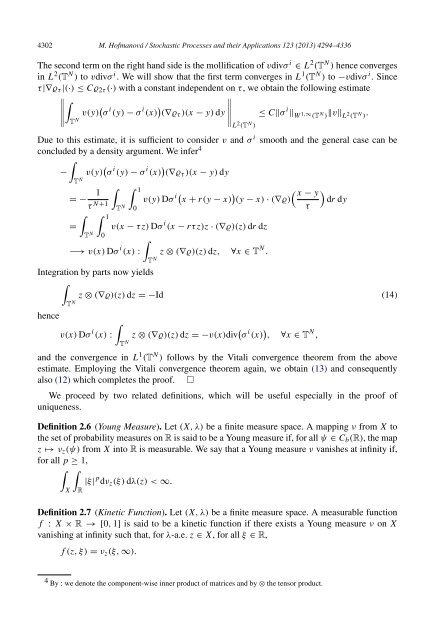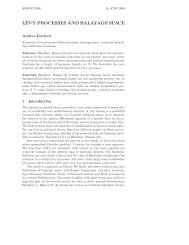Degenerate parabolic stochastic partial differential equations
Degenerate parabolic stochastic partial differential equations
Degenerate parabolic stochastic partial differential equations
You also want an ePaper? Increase the reach of your titles
YUMPU automatically turns print PDFs into web optimized ePapers that Google loves.
4302 M. Hofmanová / Stochastic Processes and their Applications 123 (2013) 4294–4336<br />
The second term on the right hand side is the mollification of vdivσ i ∈ L 2 (T N ) hence converges<br />
in L 2 (T N ) to vdivσ i . We will show that the first term converges in L 1 (T N ) to −vdivσ i . Since<br />
τ|∇ϱ τ |(·) ≤ Cϱ 2τ (·) with a constant independent on τ, we obtain the following estimate<br />
<br />
v(y) σ i (y) − σ i (x) (∇ϱ τ )(x − y) dy ≤ C∥σ i ∥<br />
<br />
W 1,∞<br />
T N (T N ) ∥v∥ L 2 (T N ) .<br />
<br />
L 2 (T N )<br />
Due to this estimate, it is sufficient to consider v and σ i smooth and the general case can be<br />
concluded by a density argument. We infer 4<br />
<br />
− v(y) σ i (y) − σ i (x) (∇ϱ τ )(x − y) dy<br />
T N<br />
= − 1 <br />
τ N+1 v(y) Dσ i x + r(y − x) x − y<br />
<br />
(y − x) · (∇ϱ) dr dy<br />
τ<br />
T N 1<br />
T N 1<br />
0<br />
= v(x − τ z) Dσ i (x − rτ z)z · (∇ϱ)(z) dr dz<br />
0<br />
<br />
−→ v(x) Dσ i (x) : z ⊗ (∇ϱ)(z) dz,<br />
T N ∀x ∈ T N .<br />
Integration by parts now yields<br />
<br />
z ⊗ (∇ϱ)(z) dz = −Id (14)<br />
T N<br />
hence<br />
<br />
v(x) Dσ i (x) : z ⊗ (∇ϱ)(z) dz = −v(x)div σ i (x) , ∀x ∈ T N ,<br />
T N<br />
and the convergence in L 1 (T N ) follows by the Vitali convergence theorem from the above<br />
estimate. Employing the Vitali convergence theorem again, we obtain (13) and consequently<br />
also (12) which completes the proof. □<br />
We proceed by two related definitions, which will be useful especially in the proof of<br />
uniqueness.<br />
Definition 2.6 (Young Measure). Let (X, λ) be a finite measure space. A mapping ν from X to<br />
the set of probability measures on R is said to be a Young measure if, for all ψ ∈ C b (R), the map<br />
z → ν z (ψ) from X into R is measurable. We say that a Young measure ν vanishes at infinity if,<br />
for all p ≥ 1,<br />
<br />
|ξ| p dν z (ξ) dλ(z) < ∞.<br />
X<br />
R<br />
Definition 2.7 (Kinetic Function). Let (X, λ) be a finite measure space. A measurable function<br />
f : X × R → [0, 1] is said to be a kinetic function if there exists a Young measure ν on X<br />
vanishing at infinity such that, for λ-a.e. z ∈ X, for all ξ ∈ R,<br />
f (z, ξ) = ν z (ξ, ∞).<br />
4 By : we denote the component-wise inner product of matrices and by ⊗ the tensor product.



